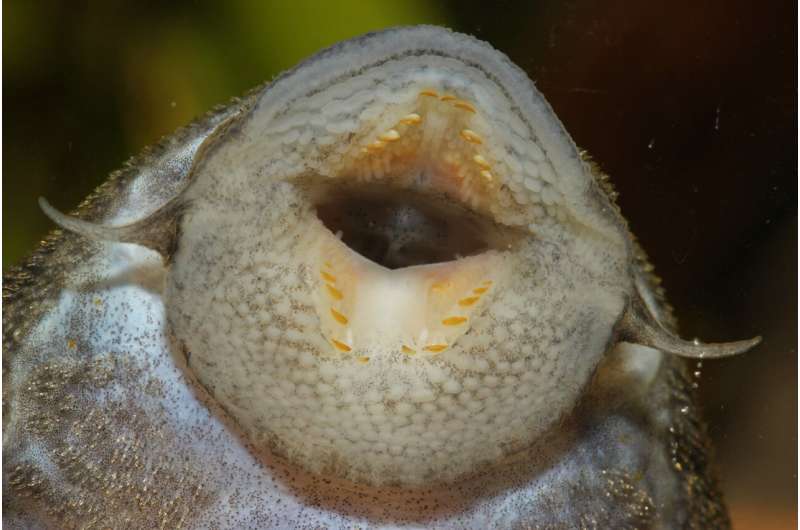This article has been reviewed according to Science X's editorial process and policies. Editors have highlighted the following attributes while ensuring the content's credibility:
fact-checked
peer-reviewed publication
proofread
The great diversity of fish mouths: Catfish attach differently than expected

Some may know suckermouth armored catfish as "window cleaners" from aquariums because they possess a suckermouth, which allows them to attach to various surfaces. The attachment is not only enabled by a vacuum created by the fish but also by specific structures of their mouths, which enable an interlocking and adhering to surfaces. A team of researchers closely examined these unique suckermouths and summarized their findings in a recent study published in Frontiers in Zoology.
The team studied a total of 67 different species of armored catfish, closely examining their mouths to gain insights into the adaptations of these animals, which allow them to attach to the different surfaces of their riverine environment. In the course of the study, they discovered a surprising diversity of mouth structures.
The morphological diversity of armored catfish is, with more than 1,000 known species, overwhelming. Females and males often differ in their appearance, which makes research even more challenging. Additionally, some species undergo significant changes in their morphology throughout their lives until they become mature. The researchers were surprised to find a variety of suckermouths that are equipped with small, slime-covered elevations called papillae.
"These are species of fish with a relatively close relationship. We thus expected one or two different adhesive structures, but not more. We would have never thought to discover such a variety of attachment structures, not only with regard to the papillae but also to their tips," says Dr. Wencke Krings, a scientist at LIB and the leading author.
"We now expect an even greater diversity in adhesive structures when we examine more species," says Daniel Konn-Vetterlein, also part of the author team. He is well acquainted with the ecology of these animals, as he observes and studies these animals in their natural habitat during his expeditions in South America. In this context, it is worth noting how the animals were collected for the study: aquarium enthusiasts willingly provided specimens, which died naturally over the years.
The structures responsible for adhesion on the catfish mouths were not entirely new to the researchers. "Here, we find shapes that we already know from insects. Insects, fish, squids—many animals that adhere to surfaces are equipped with similar structures," explains Wencke Krings.
In armored catfish, these structures are additionally covered with slime, which also increases the attachment ability through adhesion in addition to the vacuum. The researchers identified four different shapes of these papillae in the animals. The tips of these papillae are even more diverse—the team observed eight different variations that align with the known adhesive structures. Prof Stanislav Gorb from the University of Kiel, an expert in biological adhesive structures, explained the functional adaptation of the catfish papillae to corresponding substrate surfaces in nature.
Wencke Krings received support from Prof Bernhard Hausdorf, head of the Mollusca Section at the Museum of Nature Hamburg. Both are usually specialized in snails but are not entirely on unfamiliar ground. As always, the evolution of animals is at the center of their research.
In this project, Hausdorf was responsible for reconstructing the evolution of the adhesive structures in the evolutionary history. "The distribution of adhesive structures on the phylogenetic tree shows that different adhesive structures have evolved independently multiple times. Perhaps similar selection factors, such as the natural substrate to which the animals adhere have led to the parallel development of similar structures," adds Hausdorf.
"The study opens up numerous new avenues for exploration: What else can the animals do with their mouths besides suction? Which mouth is particularly suitable for which habitat? How do these territorially loyal animals cope with the changes in their ecosystems? These are questions, which could be answered by future studies of our colleagues."
More information: Wencke Krings et al, Holding in the stream: convergent evolution of suckermouth structures in Loricariidae (Siluriformes), Frontiers in Zoology (2023). DOI: 10.1186/s12983-023-00516-w
Journal information: Frontiers in Zoology
Provided by Leibniz-Institut zur Analyse des Biodiversitätswandels





















